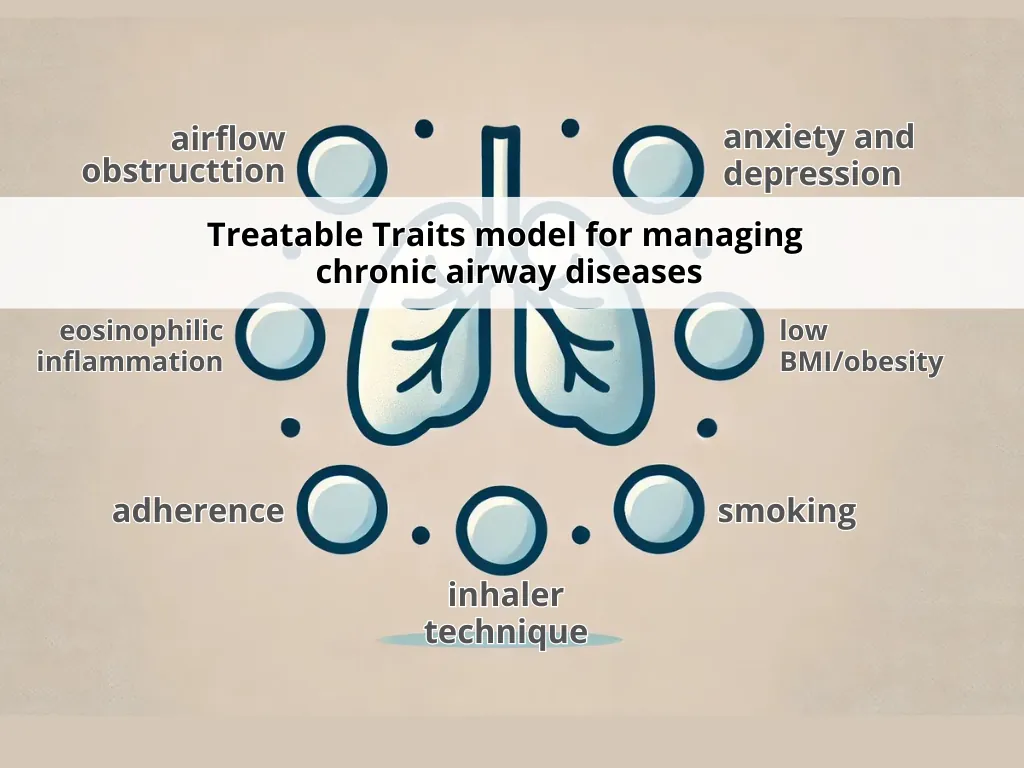Change is in the air: key questions on the ‘Treatable Traits’ model for chronic airway diseases in primary care

Introduction to the Treatable Traits Model for Chronic Airway Diseases: Personalizing Asthma and COPD Care
Despite great advancements in the treatment of chronic airway diseases, improvements in morbidity and mortality have stalled in recent years.
Asthma and chronic obstructive pulmonary disease are complex and heterogeneous diseases that require tailored management based on individual patient characteristics and needs.
The Treatable Traits (TTs) approach aims to personalise and improve patient care through the identification and targeting of clinically relevant and modifiable pulmonary, extra-pulmonary and behavioural traits.
Methods for Implementing the Treatable Traits Model in Primary Care: Key Traits and Practical Guidance
In this article, we outline the rationale for TTs-based management and provide practical guidance for its application in primary care.
To aid implementation, seven potential ‘prime’ traits are proposed: airflow obstruction, eosinophilic inflammation, adherence, inhaler technique, smoking, low body mass index/obesity and anxiety and depression—selected for their prevalence, recognisability and feasibility of use.
Conclusions on the Treatable Traits Approach: Addressing Challenges in Primary Care for Chronic Airway Disease Management
Some of the key questions among healthcare professionals, that may be roadblocks to widespread application of a TTs model of care, are also addressed.
Authors
Alvar Agusti, Peter G. Gibson, Liam G. Heaney & Mike Thomas
Read more details at
Fecha de publicación
Published: 18 July 2024
Categorías asociadas al artículo
- Anxiety/Depression-Ansiedad/Depresión, Asma-Asthma, Chronic bronchitis, Chronic bronchitis-Bronquitis crónica, Comorbidity-Comorbilidad, Iniciativa, Investigación, Limitación del Flujo de Aire-Airflow Limitation, Lung function-Función pulmonar, Rasgos tratables-Treatable traits, Tratamientos-Treatments
Noticias relacionadas

Lessons from the ANTES B+ study
Lessons from the ANTES B+ study highlighting challenges in COPD clinical trials, recruitment difficulties, and implications for future study design.

Bronchiectasis and treatable traits: the journey from concept to clinical practice
Review of the treatable traits approach in bronchiectasis, exploring phenotypes, endotypes, comorbidities, and its translation into clinical practice.

Vídeo de la Presentación de las Novedades GOLD 2026
Video de la presentación «Novedades GOLD 2026», en el que se trataron, entre otros aspectos: cambios en diagnóstico de la EPOC, tratamiento, comparativa con GESEPOC, etc.
Artículos
Asthma
- 759578·Alberto Papi et Al.-Relationships between symptoms and lung function in asthma and/or chronic obstructive pulmonary disease in a real-life setting: the NOVEL observational longiTudinal studY
- 759785·Richard Beasley et Al – Prevalence, Diagnostic Utility and Associated Characteristics of Bronchodilator Responsiveness
- 768973·James Fingleton, Rob Mclachlan, Jenny Sparks, Richard Beasley, Alvar Agusti, Peter G Gibson, Ian Pavord, Jo Hardy, Mark Weatherall, Allie Eathorne, Vanessa Mcdonal -Treatable trait guided asthma management: biomarker changes and responder analysis
- 768973·Xander Bertels et Al.- Phenotyping asthma with airflow obstruction in middle-aged and older adults: a CADSET Clinical Research Collaboration
- 769799·Alvar Agusti, Peter G. Gibson, Vanessa M. McDonald. Treatable Traits in Airway Disease: From Theory to Practice
Tratamientos
- 769273· Singh D, Criner GJ, Agustí A et al. Benralizumab Prevents Recurrent Exacerbations in Patients with Chronic Obstructive Pulmonary Disease: A Post Hoc Analysis
- 769799·Alvar Agusti, Peter G. Gibson, Vanessa M. McDonald. Treatable Traits in Airway Disease: From Theory to Practice
- 788772·Alvar Agustí et al. Add-on inhaled budesonide in the treatment of hospitalised patients with COVID-19: a randomised clinical trial
Imagen desarrollada DALL·E y Canva
